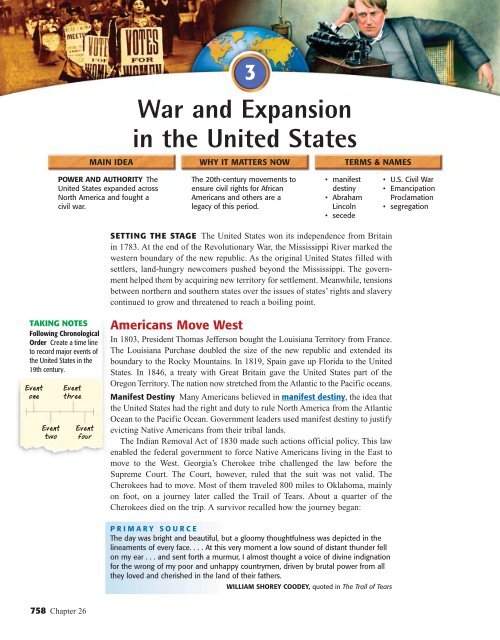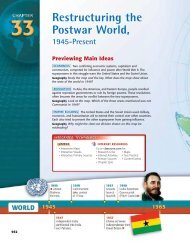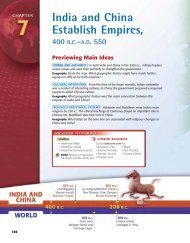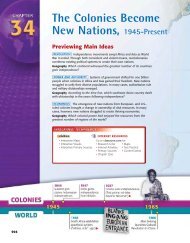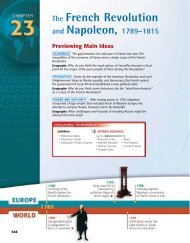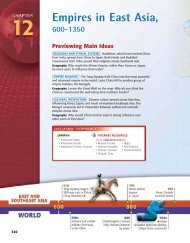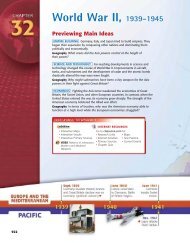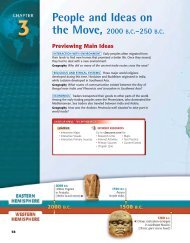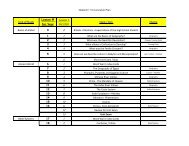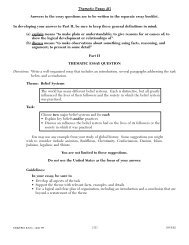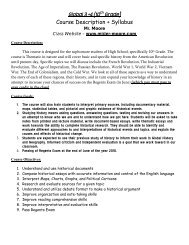The Industrial Revolution, 1700– 1900 Previewing Main Ideas
The Industrial Revolution, 1700– 1900 Previewing Main Ideas
The Industrial Revolution, 1700– 1900 Previewing Main Ideas
You also want an ePaper? Increase the reach of your titles
YUMPU automatically turns print PDFs into web optimized ePapers that Google loves.
758 Chapter 26<br />
MAIN IDEA WHY IT MATTERS NOW TERMS & NAMES<br />
POWER AND AUTHORITY <strong>The</strong><br />
United States expanded across<br />
North America and fought a<br />
civil war.<br />
TAKING NOTES<br />
Following Chronological<br />
Order Create a time line<br />
to record major events of<br />
the United States in the<br />
19th century.<br />
Event<br />
one<br />
Event<br />
two<br />
Event<br />
three<br />
Event<br />
four<br />
War and Expansion<br />
in the United States<br />
3<br />
<strong>The</strong> 20th-century movements to<br />
ensure civil rights for African<br />
Americans and others are a<br />
legacy of this period.<br />
• manifest<br />
destiny<br />
• Abraham<br />
Lincoln<br />
• secede<br />
SETTING THE STAGE <strong>The</strong> United States won its independence from Britain<br />
in 1783. At the end of the <strong>Revolution</strong>ary War, the Mississippi River marked the<br />
western boundary of the new republic. As the original United States filled with<br />
settlers, land-hungry newcomers pushed beyond the Mississippi. <strong>The</strong> government<br />
helped them by acquiring new territory for settlement. Meanwhile, tensions<br />
between northern and southern states over the issues of states’ rights and slavery<br />
continued to grow and threatened to reach a boiling point.<br />
Americans Move West<br />
In 1803, President Thomas Jefferson bought the Louisiana Territory from France.<br />
<strong>The</strong> Louisiana Purchase doubled the size of the new republic and extended its<br />
boundary to the Rocky Mountains. In 1819, Spain gave up Florida to the United<br />
States. In 1846, a treaty with Great Britain gave the United States part of the<br />
Oregon Territory. <strong>The</strong> nation now stretched from the Atlantic to the Pacific oceans.<br />
Manifest Destiny Many Americans believed in manifest destiny, the idea that<br />
the United States had the right and duty to rule North America from the Atlantic<br />
Ocean to the Pacific Ocean. Government leaders used manifest destiny to justify<br />
evicting Native Americans from their tribal lands.<br />
<strong>The</strong> Indian Removal Act of 1830 made such actions official policy. This law<br />
enabled the federal government to force Native Americans living in the East to<br />
move to the West. Georgia’s Cherokee tribe challenged the law before the<br />
Supreme Court. <strong>The</strong> Court, however, ruled that the suit was not valid. <strong>The</strong><br />
Cherokees had to move. Most of them traveled 800 miles to Oklahoma, mainly<br />
on foot, on a journey later called the Trail of Tears. About a quarter of the<br />
Cherokees died on the trip. A survivor recalled how the journey began:<br />
PRIMARY SOURCE<br />
<strong>The</strong> day was bright and beautiful, but a gloomy thoughtfulness was depicted in the<br />
lineaments of every face. . . . At this very moment a low sound of distant thunder fell<br />
on my ear . . . and sent forth a murmur, I almost thought a voice of divine indignation<br />
for the wrong of my poor and unhappy countrymen, driven by brutal power from all<br />
they loved and cherished in the land of their fathers.<br />
WILLIAM SHOREY COODEY, quoted in <strong>The</strong> Trail of Tears<br />
• U.S. Civil War<br />
• Emancipation<br />
Proclamation<br />
• segregation


